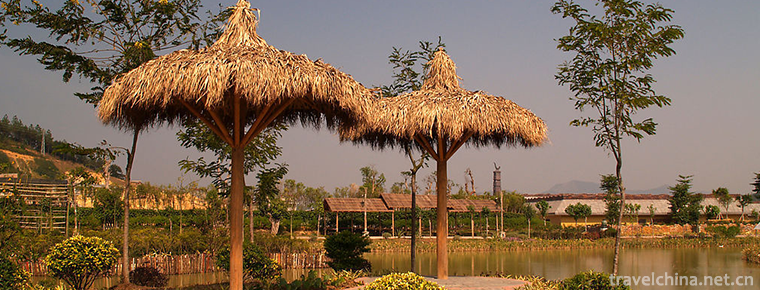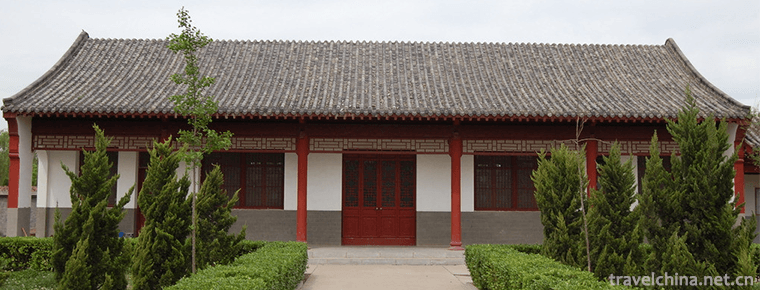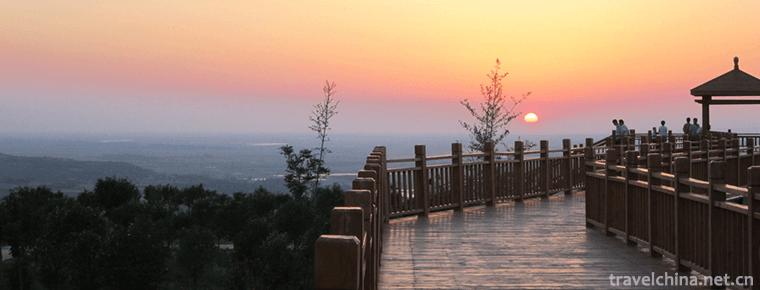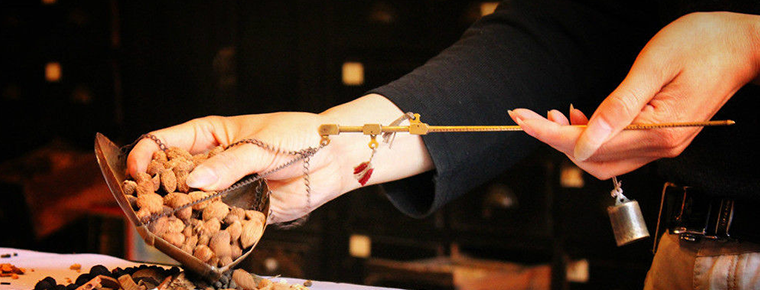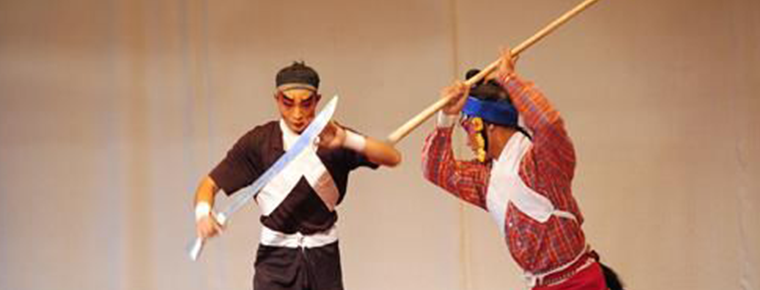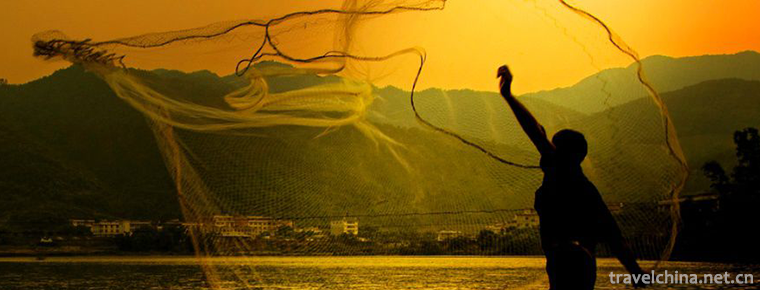Putuo Zong Cheng
Putuo Zong Cheng
Putuo Zongcheng Temple, located in the north of Chengde Summer Resort and south of Shizigou, Hebei Province, covers an area of 220,000 square meters. It is the largest of the Eight Temples outside Chengde. It was built by Emperor Qianlong in the 36th year of Qianlong in the Qing Dynasty (1771). It was built by Emperor Qianlong to celebrate his 60th birthday and the 80th birthday of his mother, Empress Dowager Budara Palace in Tibet.
The main building of Putuo Zongcheng Temple is located on the top of the mountain. There are more than 60 flat-roofed balconies and van Ta Baitai, which are freely arranged in depth with no obvious axis.
geographical environment
The layout and momentum of the temple imitate the Lhasa Potala Palace, commonly known as the "Little Potala Palace". Emperor Qianlong received the Turhu leader Oubasi and his party, who returned home from the east of ten thousand miles, and held solemn lectures, speeches and birthday celebrations.
Putuo Zongcheng Temple, located in the north of Chengde Summer Resort, was built in the 36th year of Qianlong in Qing Dynasty (1771). "Putuo Zongcheng" is the Tibetan Potala Palace. It rises step by step in accordance with the situation in the mountains. It is magnificent and magnificent.
In the thirty-sixth year of Qianlong, for the sixtieth birthday of Emperor Qianlong and the eightieth birthday of Empress Dowager Qianlong, the leaders of the minority nationalities in the border area gathered in Chengde to hold grand celebrations, which resulted in unprecedented national unity.
In order to respect the beliefs of all ethnic groups and unite the people of all ethnic groups, Emperor Qianlong ordered the construction of this large monastery.
Putuo Zongcheng Temple is the largest temple in the "Outer Eight Temple". It was built in imitation of the Lhasa Potala Palace, commonly known as the Little Potala Palace.
There are about 60 large and small buildings in this temple. The palace buildings are scattered all over the country, depending on the mountains and rivers. They are skillful in using the terrain and scenery to set off the temple. Their layout is flexible and solemn.
The main building is Dahongtai, 43 meters high. The Wanfayidian Hall in the center of the platform is the main hall. The top of the hall is higher than the buildings. The top of the hall is covered with gold fish scales and copper tiles. It is magnificent and magnificent.
At the bottom, because of the three-storey complex, the shadows and the bright contrast of light, it creates a solemn and solemn atmosphere of religion, which is the treasure of religious architecture.
The "Royal Tower" on Dahongtai solemnly launched the national religion song and dance "Light of Putuo". By refining the important events such as the completion of temples, the celebration of the emperor's birthday and the return of the Turhut tribe, it shows the strong centripetal force and cohesion of the Chinese nation during the prosperous period of Kangqian and the common aspiration of the people of all nationalities to create a prosperous era of Taiping and prosperous China in the form of singing and dancing. Every morning, visitors can enjoy the "Light of Putuo" on the "Imperial Tower" where the former emperors enjoyed singing and dancing.
At that time, most of the minority nationalities in the border area respected Tibetan Buddhism. Lhasa Potala Palace is a center of Tibetan Buddhism. Tibetan Buddhism claims that the Potala Palace is the Taoist site of Guanyin Bodhisattva.
It is said that there are three Taoist sites of Guan Shiyin Bodhisattva: one in India, one in Tibet and one in the South China Sea (Mount Putuo, Zhejiang). Emperor Qianlong believed that Guanyin originated in India, and then went to Tibet as its native land. Therefore, in the construction of Guanyin Taoist venue, it was "imitated Tibet, not the South China Sea".
Putuo Zongcheng Temple is built on the basis of the traditional architecture of the Han nationality and combines the characteristics of Tibetan architecture. It is a model of the blending of Han and Tibetan architectural art.
building structure
The Temple of Putuo Zongcheng was built in imitation of the Potala Palace in Lhasa, Tibet. The "Putuo Zongcheng" is a Chinese translation of the Tibetan word "Potala". The temple is built on the hill, sitting in the north and facing the south. Inside the mountain gate is a stele pavilion. In the north is a Five-Pagoda gate. It is more than ten meters high and has three arches. Five Lama pagodas, red, yellow, black, white and green, are built.
Menbei is a glazed archway. The northern topography of the memorial archway is gradually rising, and all kinds of white terraces and towers are scattered due to the topography, with varying heights and ends. Finally, for the grand and tall main building Dahongtai.
On the front of Dahongtai, there is a big white platform up to eighteen meters below, on which stands a big red platform up to twenty-five meters.
There are three-storey buildings around Hongtai, and in the center is the Hall of "All Facts and Unification" of the Heavy eaves and Cunjian Gold and Copper Tiles. The layout of Putuo Zongcheng Temple is divided into three parts: the front part includes the mountain gate, the stele Pavilion and the five pagodas gate; the middle part includes the Liuli archway, the Baitai and the monk house; the rear part is the main building Dahongtai and other buildings around it. There are more than 60 large and small places, which are surrounded by the tall wall around the temple, which is connected by pheasants and surrounded by the ups and downs of the mountains.
Walking through the five-hole stone bridge and entering the Tibetan-style Mountain Gate is a pavilion covered with yellow glazed tiles.
Three stones are erected in the pavilion. They are distributed in four languages: Han, Manchu, Mongolian and Tibetan: The Monument of the Temple of Putuo Zongcheng, The Record of All Turhut's Return to Shun and The Records of All Turhut's Compassionate Turhut's Departments People.
Behind the stele Pavilion is the Five Towers Gate. The five pagodas are white, with three layers of Tibetan blind windows, three arches below, five Lama pagodas on the top of the door, and a large stone statue in front of the door, which symbolizes auspiciousness and the infinite power of the Mahayana School of Buddhism.
Practical information
Joint Ticket with Xumi Fushou Temple: 80 yuan Putuo Zongcheng Temple belongs to one of the Eight Temples outside Chengde. It is located in the hinterland of Yanshan Mountain, the transition area between Inner Mongolia Plateau and North China Plain. It belongs to the transition zone from sub-temperate zone to sub-frigid zone. It has semi-humid, semi-arid and continental monsoon mountain climate. It has bright seasons, abundant sunlight and wide temperature difference between day and night. The average annual temperature is about 8.8 C and the frost-free period is 160 days. In winter, although it is cold, but because of the surrounding mountains, which blocked the attack of cold currents from the Mongolian Plateau, the temperature is higher than other areas in the same latitude; in summer, it is cool, concentrated rainfall, basically no hot season, and it is a tourist summer resort.
Optimum travel time: All seasons are suitable, but considering its seasonal beautiful natural scenery, April-October is the best.
Get accommodation
Chengde City is a small city. Chengde City Hotel can be accommodated by visiting Putuo Zongcheng Temple. Chengde accommodation as a whole is expensive (late April to early October in peak season, off-season discounts), we should be prepared. There are many hotels in all grades. The rooms are very tense during the weekend in peak season, so we need to make preparations early.
diet
Should eat Zhai
Special flavor snacks include: baking, crispy baobao, Babao rice, Erxianju bowl, 100 families of buckwheat noodles, cake and cold powder, donkey roll, baking cake, pancake box, naked oat noodles snacks, Bagou baked cake, sheep soup, fresh flower rose cake, Nansha cake, fruit Danpi and so on, with unique local characteristics.
Shopping
Chengde is rich in chestnuts, and there are many varieties, such as black chestnuts, red chestnuts, red oil chestnuts, rhubarb chestnuts, white chestnuts, green chestnuts, a nest of peak chestnuts, double-kernel chestnuts and so on. In particular, the chestnuts produced in Xinglong and Kuancheng counties are well-known and excellent varieties in China, which are generally called "Jingdong chestnuts". Jingdong chestnut is reddish-brown with thin skin and milky white flesh. It tastes tender and crisp, sweet and easy to peel. Chestnut contains a lot of vitamins, protein, sugar, calcium and other necessary nutrients for human body. Chengde chestnut is popular both at home and abroad, and has won high praise from all walks of life.
Tips
The scenic spots are mainly the first three of the Summer Resort and the eight temples. The Summer Resort Palace District suggests to find a tour guide to explain.
The eight major temples are all Lama temples, and most of them come from Tibet, Qinghai and other places. Attention should be paid to their privileges and they should not be offended unless they are under the jurisdiction of the local government. Of course, their practitioners are generally very good and friendly. Just ask for a group photo, never entanglement, delaying other people's practice. When entering a monastery, we should pay attention to words and deeds, especially when we are not polite. In addition, when turning the warp barrel in the monastery, it should circle the hall clockwise, and the warp barrel should also turn clockwise (1 circle, 3 circles, 7 circles, etc.). To be sincere, it is better to recite the 6-character Daming Mantra sincerely at the same time, which is more meritorious. Six-character Daming mantra is best pronounced in Sanskrit. The pronunciation is roughly "hum, ni, beautifully coaxed", and it is better to imagine Guanyin Bodhisattva. Guanyin Bodhisattva is responsive and very effective. It must not be reversed. That is a great sin. Chengde sunny day is the sun burning, it is best to take an umbrella or square sunshine; the night is cooler, pay attention to warmth.
Traffic information
Long distance passenger transport
Chengde has reached more than 6,000 kilometers of traffic mileage. Chengde highway transportation network, with Beijing-Chengdu tourist highway, Chengwei highway, 101 national highway, 111 line, 112 line, Chengdu ticket highway as the main road, has realized the interconnection of Chengde city with Beijing, Tianjin, Liaoning and other places; in the city, villages and villages are connected by highways, and travel is convenient.
In Chengde Long-distance Bus Passenger Station, there are long-distance passenger cars to Beijing, Tianjin, Shijiazhuang, Zhangjiakou and other nearby provinces and cities every day. In addition, there are buses to all counties and districts in Chengde Bus West Station and North Station every day.
City traffic
Direct Bus No.6








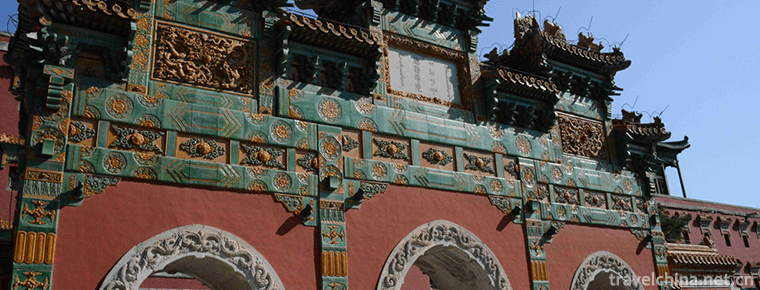
-
Senbora Resort Forest Scenic Area
Senbora, a landscape world in ancient forests, a paradise of pleasure water under glacial ruins, a national 4A-class tourist attraction, is located at the exit of Fogang Expressway in Fogang County.
Views: 187 Time 2019-02-07 -
Yicheng Temple Scenic Spot of Sun Bin Tourist City
Sun Bin Tourist City is located in Jishan Town, 20 kilometers northeast of Juancheng County, Heze City, Shandong Province. Juancheng is the hometown of Sun Bin, a famous.
Views: 80 Time 2019-02-13 -
Tongguan Yellow River Scenic Area
Tongguan Yellow River Scenic Spot is located at the famous ancient military pass-Tongguan ancient city, 140 kilometers away from Xi'an, only 20 kilometers away from Huashan.
Views: 81 Time 2019-02-22 -
Traditional medicine
Traditional medicine, a list item of intangible cultural heritage. Article 21 of the Constitution stipulates that the State shall develop medical and health undertakings, modern medicine and tradition.
Views: 276 Time 2019-04-21 -
Da Xian Opera
Daxian opera is a local traditional drama in Huaxian and Puyang counties of Henan Province, and one of the intangible cultural heritage at the national level. The singing music of Daxian opera belongs.
Views: 198 Time 2019-04-23 -
Mongolian camel raising custom
The Mongolian camel-raising custom has a long history. In the practice of production and life with a long history, camel has become the most loyal partner of mankind while making outstanding.
Views: 83 Time 2019-06-04 -
Tianmen Folk Song
Tianmen folk song is the traditional folk music of Hubei Province. Tianmen folk song has its unique style characteristics. It is not as rough and elegant as plateau folk song, nor as broad and long as.
Views: 130 Time 2019-06-20 -
Production Techniques of Black Copper Walking Silver
The process of making silver from black copper is very complicated. Usually, it has to go through nearly 20 processes, such as refining copper, blanking, pattern carving, silver walking, forming, poli.
Views: 144 Time 2019-06-29 -
Fishing Song
Fishing songs are a kind of Chinese folk songs sung by fishermen in coastal areas of China and lakes and harbours. If popular in Shanwei City, Guangdong Province, collectively known as Shanwei Fishing.
Views: 172 Time 2019-07-14 -
Daci Temple
Daci Temple, also known as the ancient great saint CI temple, is located in the first section of Dongfeng Road, Jinjiang District, Chengdu City, Sichuan Province. It was built between the 3rd and 4th centuries AD, and is known as "the first jungle of the Sinian"..
Views: 100 Time 2020-11-05 -
Daofu steamed bun with beef and mutton
Steamed bun with beef and mutton is a special traditional delicious food of Hui nationality. It is famous at home and abroad for its strict selection of materials, cooking essence, rich nutrition and mellow taste. The eating method of beef and mutton steamed .
Views: 348 Time 2020-12-06 -
Explanation service of Chengdu Giant Panda Base
Chengdu Research Base of giant panda breeding has set up an explanation service station at the entrance to provide high-quality explanation service for tourists who have a better understanding of giant panda knowledge. At present, there are 11 full-time commentators in the.
Views: 384 Time 2020-12-13
